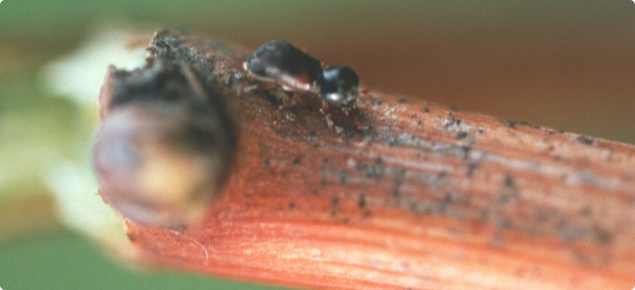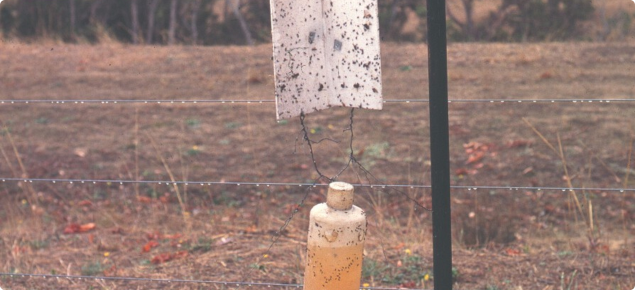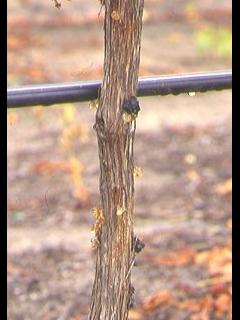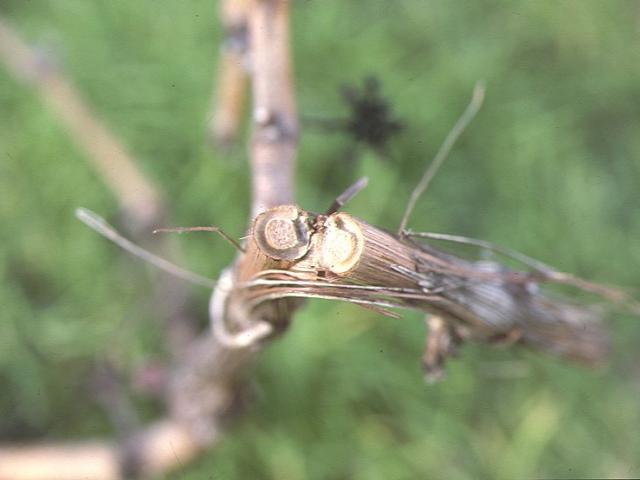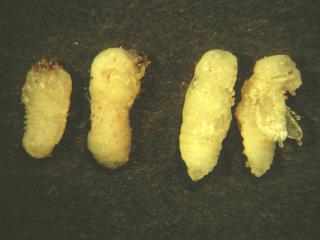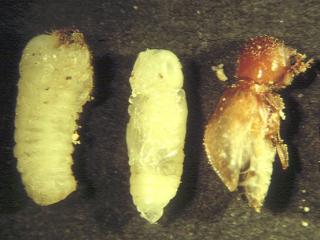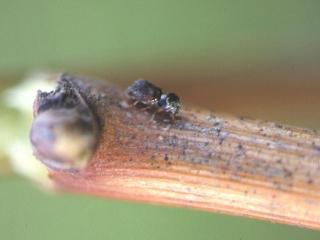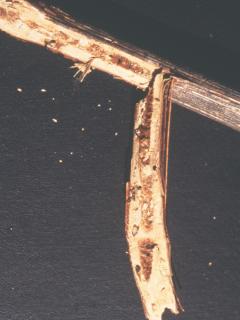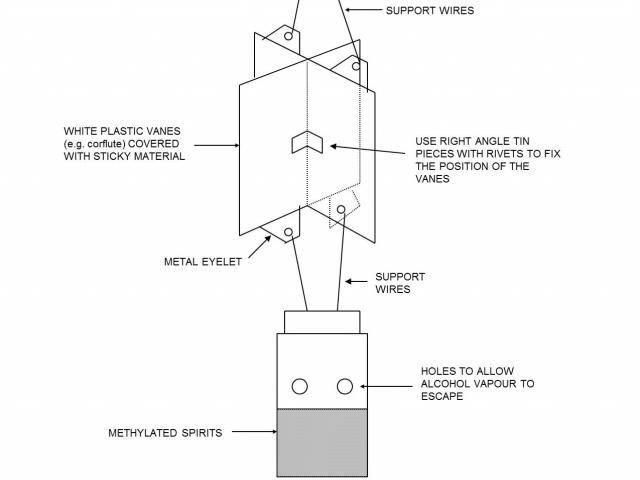Damage
The adult stage of the common auger beetle is the damaging stage of this insect. It does not feed on healthy conductive tissue of the wood of vines, but bores to that depth.
Certain varieties of vines are more susceptible, with Semillon the most susceptible.
In situations of heavy infestation, copious sap exudation from trunks, arms and canes of vines will be evident just before and during early dormancy.
Recent sap exudate is honey-brown and sticky, and with exposure to air becomes sooty/black and not sticky. This loss of sap reduces the vigour of vines resulting in lower yields.
Internal girdling of a grapevine cane by adult beetles weakens the cane, causing it to snap when being laid down on vines being cane-pruned.
On rare occasions reports have ben received of the adult common auger beetles boring holes into irrigation lines. Such damage usually occurs near the juctions of PVC pipes.
Description
The larval stage of common auger beetle is cream to white. Larvae have black jaws and no legs: mature larvae are small, 3mm long and 1mm in diameter. Larvae are wood borers, feeding internally in branches of certain types of wood, after sap flow has been cut from the parent plant.
In vineyards, they feed within canes and almost exclusively only in pruned canes, in the season that the canes have been removed.
When mature, larvae moult into the pupal stage within vine canes. At first, pupae are cream-coloured but become brown as they develop into adults.
Adult common auger beetles are small black/brown beetles about 2mm long and 1mm wide, with a rounded head. The end of the adult’s abdomen is flat, giving the appearance as if it has been sliced off. Adult beetles actively fly.
Looks like - similar insects
The common auger beetle adult may be confused with the small fruit tree borer (Xyleborus dispar). However, the small fruit tree borer is smaller and less common in vineyards. Other insects which bore into the wood and canes of grapevines include fig longicorn beetle (Acalolepta vastator), large auger beetle (Bostrychopsis jesuita), elephant weevil (Orthorhinus cylindrirostris), vine weevil (Orthorhinus klugi), and fruit-tree borer moth (Maroga melanostigma) and vine borer moth (Echiomima sp.). See Further reading below for details on these insects.
Although all these other species of borers have been recorded as causing economic damage in vineyards in eastern Australia, none have been recorded as pests in Western Australia and some do not occur in Western Australia.
Habits
Adults are attracted to volatile chemicals given off by plants when they are under stress, or have recently died. This process is enhanced by adults internally ringbarking vine canes, to enable their premature senescence: such canes become a suitable place for the beetle to lay its eggs and larvae to develop.
Adults can fly and invade vineyards from nearby bush.
Life cycle
Larvae are most abundant in vine canes in summer, but only in cane prunings of the previous season. In heavy infestations, common auger beetles turn the wood of canes to dust as the larvae completely riddle them.
Pruned canes from earlier seasons are too dry to be infested, or were infested in previous seasons and all beetles have since emerged. Adults emerge from infested canes during late summer. They probably lay eggs in vine canes from late summer to spring.
Large flights of beetles have been recorded in baited sticky traps both in late summer and spring - for details of such traps, see below.
Monitoring
Sap exudate from vine trunks, leaders and canes from late summer to early winter indicates the presence and seveity of an infestation of common auger beetle.
Holes of about 1 millimetre diameter in canes from the previous season, either in pruned canes on the ground and in the vine canopy, and problems with canes snapping during pruning also indicate that the beetle is present.
Adult beetle abundance and their activity can be assessed using sticky traps. This involves hanging bottles containing methylated spirits beneath a surface coated with a sticky material such as polybutane. The beetles are attracted to the evaporating alcohol and get caught in the sticky surfaces. Refer to the diagram below and suggestions for making, deploying and servicing traps.
Control options
Cultural
- Mulching pruned canes to enable them to dry out should break the cycle of the beetle within a vineyard. Sweep pruned canes from under vines to the inter-row for best effect. Pruned cane material will dry out best when it is broken open and mulched into very small pieces. Mulching may not give complete control of the beetle, but will help to reduce numbers considerably. In vineyards with heavy beetle activity, consider removing cane prunings from the vineyard and destroying them by mulching, burning or burying.
- Maintaining good vine vigour may help vines tolerate auger beetle feeding.
- Because it is very difficult to lay down replacement canes in severely infested blocks if they are cane pruned, such blocks should be spur pruned until beetles are controlled.
Chemical
- Refer to the Viticulture Spray Guide for chemicals registered for this pest. However, the cultural control option is preferred. If spraying is considered, suggested times for application are after vintage and again in spring. For more precise timing of sprays, monitor adult flight activity with sticky traps as indicated in the diagram and described below.
- When grafting chip buds, common auger beetle may move in and feed in the area of the graft union in a short period of time. The resultant sap excreted by the vine may inhibit callusing, resulting in the death of the graft. Spot spraying after the grafting may alleviate such damage.
Sticky traps
Assemble traps using the diagram as a guide.
The sticky material that is used to coat the surface of the plastic vanes to trap insects can be purchased as Bird-Off in cartridge form or as TAC-GEL in bulk form from local hardware stores. Immersing the container of the sticky product in hot water makes it spreadable.
As the sticky material on the traps becomes caked with debris after exposure, replace the vane assembly complete with fresh sticky material. Solvents for the sticky material include kerosene and baby oil.
Place one trap adjacent to heavily infested areas on the fenceline, or on a steel picket at or above crop height where the trap can be accessed easily. Avoid dusty areas.
Count the beetles on a regular basis without removing them. Subtract successive counts from the previous count to determine the number of adults caught during the intervening period. Replace the trapping surface when it loses its stickiness, or becomes clogged with insects.
Further reading
Nicholas, P, Magarey, P and Watchel, M (eds) 1994, Diseases and Pests – Grape Production Series Number 1, Winetitles, Adelaide.


